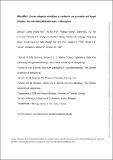MicroRNA clusters integrate evolutionary constraints on expression and target affinities : the miR-6/5/4/286/3/309 cluster in Drosophila
Abstract
A striking feature of microRNAs is that they are often clustered in the genomes of animals. The functional and evolutionary consequences of this clustering remain obscure. Here, we investigated a microRNA cluster miR-6/5/4/286/3/309 that is conserved across drosophilid lineages. Small RNA sequencing revealed expression of this microRNA cluster in Drosophila melanogaster leg discs, and conditional overexpression of the whole cluster resulted in leg appendage shortening. Transgenic overexpression lines expressing different combinations of microRNA cluster members were also constructed. Expression of individual microRNAs from the cluster resulted in a normal wild-type phenotype, but either the expression of several ancient microRNAs together (miR-5/4/286/3/309) or more recently evolved clustered microRNAs (miR-6-1/2/3) can recapitulate the phenotypes generated by the whole-cluster overexpression. Screening of transgenic fly lines revealed down-regulation of leg patterning gene cassettes in generation of the leg-shortening phenotype. Furthermore, cell transfection with different combinations of microRNA cluster members revealed a suite of downstream genes targeted by all cluster members, as well as complements of targets that are unique for distinct microRNAs. Considered together, the microRNA targets and the evolutionary ages of each microRNA in the cluster demonstrates the importance of microRNA clustering, where new members can reinforce and modify the selection forces on both the cluster regulation and the gene regulatory network of existing microRNAs.
Citation
Qu , Z , Yiu , W C , Yip , H Y , Nong , W , Yu , C W C , Lee , I H T , Wong , A Y P , Wong , N W Y , Cheung , F K M , Chan , T F , Lau , K F , Zhong , S , Chu , K H , Tobe , S S , Ferrier , D E K , Bendena , W G & Hui , J H L 2020 , ' MicroRNA clusters integrate evolutionary constraints on expression and target affinities : the miR-6/5/4/286/3/309 cluster in Drosophila ' , Molecular Biology and Evolution , vol. 37 , no. 10 , msaa146 , pp. 2955-2965 . https://doi.org/10.1093/molbev/msaa146
Publication
Molecular Biology and Evolution
Status
Peer reviewed
ISSN
0737-4038Type
Journal article
Description
This research was supported by the Hong Kong Research Grant Council GRF Grant (14103516), The Chinese University of Hong Kong Direct Grant (4053248), and TUYF Charitable Trust (6903957) (JHLH).Collections
Items in the St Andrews Research Repository are protected by copyright, with all rights reserved, unless otherwise indicated.

